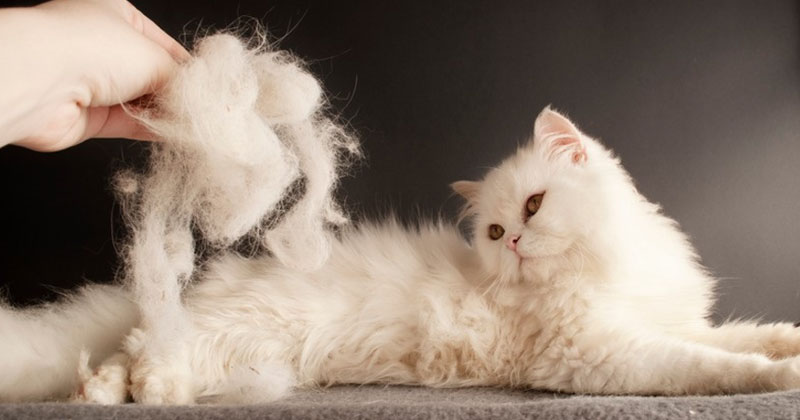
It’s not unusual to notice your cat is shedding on a regular basis. Cats naturally shed their fur, but when the shedding becomes excessive or results in noticeable bald patches, there may be an underlying issue. As a caring pet owner, you want to ensure your cat's health and well-being. At Skyline Veterinary Clinic, we’re here to help you better understand the possible reasons behind your cat’s hair loss and can help you determine when your feline friend’s condition requires professional veterinary attention.. For more information, call us at (402) 933-6800 or request an appointment.
While some shedding is normal, hair loss that leaves bald spots or significant thinning of fur may signal a deeper issue with your cat’s health. Hair loss, also known as alopecia, can result from various factors ranging from allergies to stress. Below, we’ll explore some of the most common causes of hair loss in cats.
These allergies may be caused by environmental factors such as pollen, mold, or dust mites, or they may develop in response to certain foods. Flea bites are also a common allergen, and in some cases, a single flea bite can cause intense itching and hair loss. Cats with allergies may excessively groom themselves, leading to bald spots, especially around the head, neck, or back. If you suspect your cat is dealing with allergies, a veterinarian can help identify the allergen and suggest a treatment plan. Limiting exposure to allergens and using prescribed medications can alleviate the symptoms.
These pests can irritate your cat’s skin, causing itching, inflammation, and hair loss. Some parasites, like mites that cause mange, burrow into the skin, leading to more severe hair loss and other skin problems. Fleas, particularly, are notorious for causing dermatitis, which can result in extensive fur loss. Treating your cat for parasites with flea and tick preventatives is essential to preventing discomfort and hair loss. Regular check-ups can help ensure your cat remains free from these pests.
Ringworm, a fungal infection, is especially common and causes circular patches of baldness. Cats with ringworm often experience redness, scaling, and hair loss on affected areas. Bacterial infections, on the other hand, may develop as a secondary issue if your cat has been scratching or licking an area too much due to another condition. Schedule a visit with Skyline Veterinary Clinic if you notice signs of infection. Infections need proper treatment, such as antifungal or antibiotic medications, to prevent them from worsening.
In some cases, hair loss in cats can be attributed to hormonal imbalances or other underlying medical conditions. These issues require prompt veterinary attention and specific treatments to address both the hair loss and its root cause.
Hyperthyroidism, a condition where the thyroid gland produces too much thyroid hormone, can lead to various symptoms, including hair loss. Cats with hyperthyroidism may also show signs of weight loss, increased appetite, and restlessness. The overproduction of thyroid hormone can speed up the metabolic processes in your cat’s body, affecting their skin and coat health. If your cat has been diagnosed with hyperthyroidism, treatment options like medication or dietary changes can help manage the condition and reduce hair loss.
Cushing’s disease, also known as hyperadrenocorticism, occurs when the body produces too much cortisol, a hormone that helps regulate stress and inflammation. Cats with Cushing’s disease may experience hair thinning, weight gain, and increased thirst. Cortisol imbalance can affect your cat’s coat and skin, leading to hair loss over time. Diagnosing Cushing’s disease involves blood tests and other diagnostic tools. Treatment will depend on the severity of the condition, and managing the disease can help improve your cat’s coat condition.
Diabetes affects your cat’s ability to regulate insulin and blood sugar, leading to several health complications. Cats with diabetes may exhibit signs of excessive thirst, frequent urination, and weight loss. Hair loss in diabetic cats is often associated with poor skin condition and slow healing of wounds. Managing diabetes with insulin therapy and a balanced diet is essential for overall health, and it can help improve skin and coat quality as well.
Not all hair loss is caused by medical conditions. In some cases, behavioral factors, particularly stress, can contribute to excessive grooming and hair loss in cats.
Cats are known for their grooming habits, but when a cat is stressed, they may begin to overgroom. Overgrooming, also known as psychogenic alopecia, can lead to hair loss in patches, especially on the belly, legs, and sides. Stress can stem from changes in your cat’s environment, such as moving to a new home, the introduction of a new pet, or changes in their daily routine. If your cat is overgrooming due to stress, try to identify the stressors and create a calming environment. Your veterinarian may recommend behavior modification techniques or anti-anxiety treatments to help your cat relax.
Cats are territorial animals, and conflicts with other pets in the household can also lead to stress-induced hair loss. If your cat feels threatened or insecure, they may groom excessively as a way to cope. This behavior can result in noticeable hair thinning, particularly in areas they can easily reach with their tongue. In multi-pet households, monitor the dynamics between animals and ensure that each cat has their own safe space. Separating food bowls, litter boxes, and beds may help reduce stress and prevent hair loss related to territorial disputes.
If your cat's hair is falling out, consult with your veterinarian at Skyline Veterinary Clinic to identify the underlying cause. While some causes, such as stress or mild allergies, can be managed at home with environmental changes, other conditions like infections, parasites, or hormonal imbalances require veterinary treatment. Your veterinarian can conduct tests to pinpoint the cause of hair loss and recommend appropriate treatments. Depending on the cause, treatments may include medications, changes in diet, or other targeted therapies to restore your cat’s coat and overall health. For professional guidance and care, reach out to Skyline Veterinary Clinic. Call (402) 933-6800 or request an appointment today.


